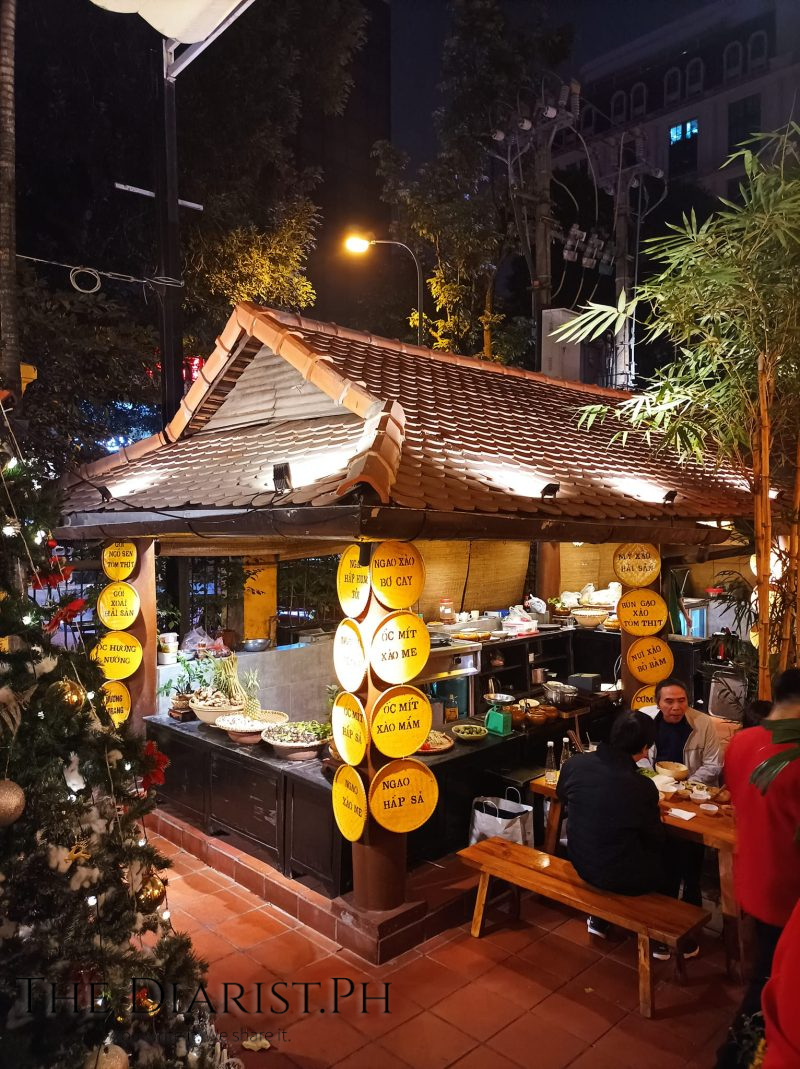
Quan An Ngon Restaurant, Hanoi
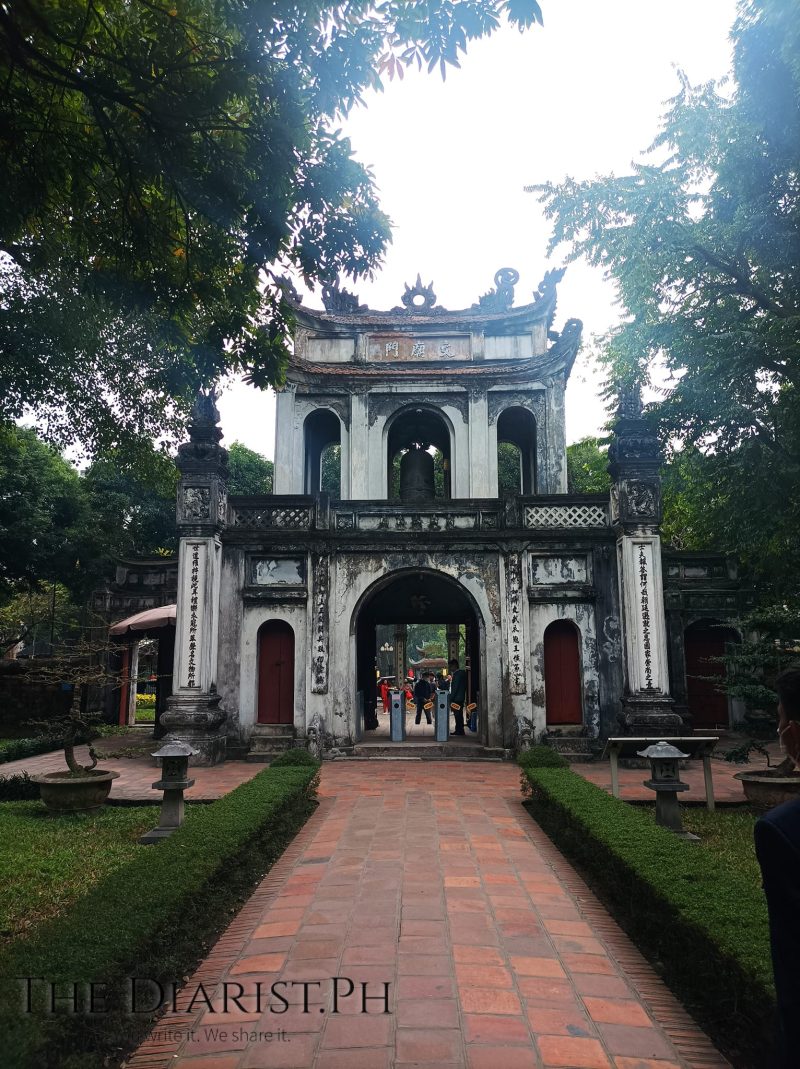
Hanoi’s Temple of Literature (Van Mieu)
After two straight years of pandemic lockdown and mostly self-imposed isolation, I started accepting invites the last two months of 2022. Celebrating birthdays face-to-face, watching concerts, performances, and live theater again, attending art exhibits, and meeting up with friends can be unbelievably intimidating after being cooped up and getting used to the quiet confines of home. With a vengeance, I took in stride the prospect that somewhere out there, other strains of the corona virus are still lurking. While still mindful of masking up, one, however, can’t eat and savor the goodness of crunchy cochinillo and lechon with mask on. And as we throw caution to the wind, beso-beso is such a sweet surrender to the excitement of meeting up again.
Then I caught it, even after two doses of Sinovac vaccine and two Moderna booster shots, with no other symptoms but aching muscles. My daughter Banaue gave me paracetamol which put me in deep slumber. I prided myself in being the “last person standing” after my husband Mario and Banaue’s family all caught COVID-19 in March 2021, with my Mario tragically succumbing to it on Resurrection Day. But this time, I was not spared. Fortunately, I must have caught the benign strain, and without comorbidity, I got well in just three days.
With immunity protection said to be acquired by people who recovered from COVID-19, I got bolder not just to go out, but also to travel.
When Mario passed away, I was despondent and thought that I could not travel again without my best travel buddy. American historian and women’s suffrage activist Mary Ritter Beard said, “Travel is more than the seeing of sights; it is a change that goes on, deep and permanent, in the ideas of living.”
I decided to build new memories at the onset of the new year. I accepted the invitation of my husband’s two sisters, Beth and Lynn, and her hubby to join them and their brother Mon and his wife Vangie on their trip to Vietnam. The three are based in the US and visiting the Philippines. Mario’s elder sister, ate Beth, lost her husband three years back and I liked the idea that we two widows would be bonding as roommates. It turned out to be a most comforting trip with her, like when the two men were still around; we two couples had a great time together every time they came to visit.

Ho Chi Minh’s study and bedroom
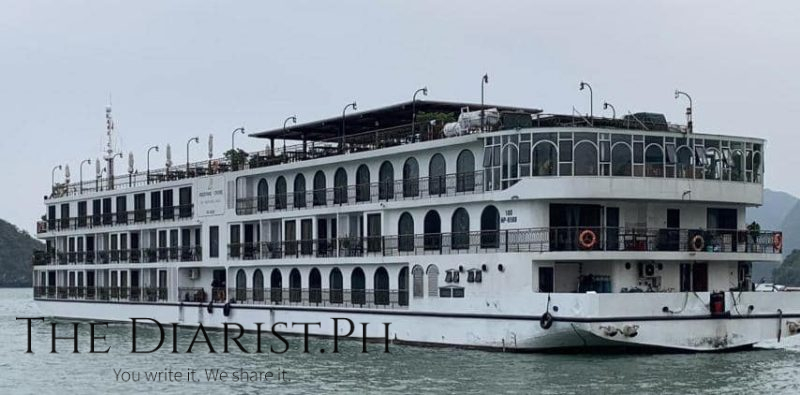
The cruise ship

The cruise ship’s stairway

The author enjoying the cruise ship’s cabin with the view of Ha Long limestone islands
After failing to book any local trip, the balikbayans settled for Vietnam—Ho Chi Minh City in the south and Hanoi in the north, with a cruise on Ha Long Bay. I’ve been to Hanoi but not to Ha Long Bay, and I’ve not been to Ho Chi Minh City either. The latter was the name given to Saigon to honor Vietnam’s revered leader who led the Việt Minh independence movement in 1941 against the French colonialists, and was the key figure in the People’s Army of Vietnam and the Việt Cộng during the Vietnam War, which lasted from 1955 to 1975. He served as prime minister of Vietnam from 1945 to 1955, and as president of Vietnam from 1945 until his death in 1969.
From Ho Chi Minh City where we spent our New Year, we flew to the capital Hanoi. The contrast between the two cities—vibrant and laid-back Saigon with modern architecture, and Hanoi’s old world charm, evident in the French influence on the architecture of the buildings and houses, and even in the elevator—extended to our guides. Doan from Saigon is gregarious, talks a lot and speaks his mind, and is always in a hurry; Quang from Hanoi is soft-spoken and Mandarin-like, rather deep and steeped in history.
The Vietnamese people’s guerrilla warfare against the mighty power of the US invaders can be experienced through the Cu Chi Tunnels

The author at the Cu Chi tunnel, a labyrinth of narrow tunnels used by the Vietnamese as hideout during the Vietnam War
Ho Chi Minh City’s modern history of the Vietnamese people’s guerrilla warfare against the mighty power of the US invaders can be experienced through the Cu Chi Tunnels, where the guerrillas built a labyrinth of narrow tunnels as their hideouts during the war.

The author and her travel companions Beth, Lynn and Vangie at Notre Dame Cathedral in Ho Chi Minh
Other highlights of the city are the Independence or Reunification Palace, the site of the Fall of Saigon on April 30, 1975, and now a museum, as well as the Notre Dame Cathedral of Saigon built in 1863 by the French colonialists 700 years after they built Notre Dame de Paris. The Saigon Cathedral, however, was being renovated, so unlike the time Mario and I visited Paris and got to enjoy the fabled Notre Dame de Paris.
‘If Saigon is the commercial area, Hanoi is the food capital’
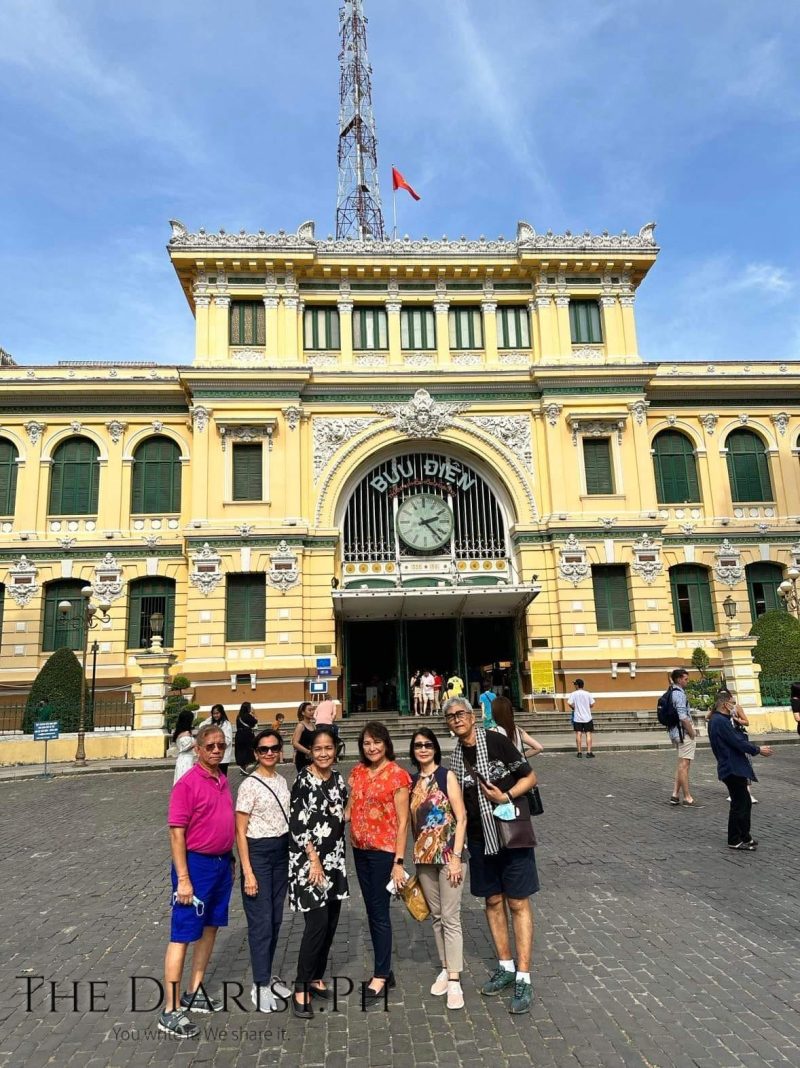
The author’s fellow travelers at Saigon Central Post Office
We also visited the imposing Central Post Office and Quan Am Pagoda. A stop-over in the local market yielded durian, large atis or custard apple, mangoes and guavas. Said our guide: “If Saigon is the commercial area with around 10 million population, Hanoi, with around 8 million people, is the food capital.”
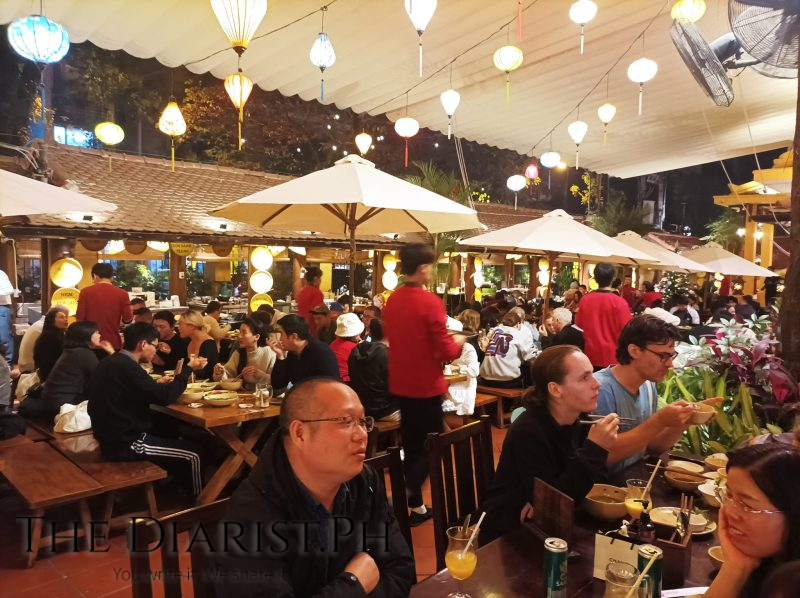
Quan An Ngon restaurant diners in Hanoi
True enough, our initiation to Hanoi was through a marvelous dinner at Quan An Ngon, which means “delicious restaurant,” serving authentic Vietnamese cuisine prepared in street-stall style pavilions around the courtyard garden. It was a delicious start to what would be a wonderful stay in this city of admirable people.
Another feast for the senses and the tummy was at KOTO Restaurant, which runs a two-year vocational program for the underprivileged and at-risk youth in Vietnam ages 16 to 22. KOTO, which means Know One, Teach One, helps them pursue careers in hospitality so they can work in restaurants, hotels, bars, cafes, and in catering. Some become chefs and return to KOTO to teach.
From Ho Chi Minh City’s Liberty Central Saigon Riverside Hotel, which is lovely and scenic, we were ushered in at Lapis Hotel in Hanoi, in what seems like an embassy row where the Philippine Consulate is just a stone’s throw away.

The traveling group in front of Ho Chi Min Mausoleum in Hanoi

Prersidential Palace, Hanoi
Visiting the Ho Chi Minh Mausoleum and the former residence of the revered Vietnamese leader is a must. The simple and frugal hero of the revolution, statesman and leader of independent Vietnam did not live in the stately presidential palace where he just received official state visitors. Instead, he chose to live in a simple house on stilts at the back of the presidential palace. The most exemplary leader worthy of his place in history catapulted this brave, proud, and resilient nation to what it is today—fast developing, with a vibrant economy.
Our tour guide Quang gladly showed us the lacquerware factory and the thriving Legend Pearl Halong Bay factory which cultures three kinds of pearls: Akoya, South Sea, and black pearls. We also visited the famed Van Mieu–Quoc Tu Giam (the Temple of Literature), one of the most visited historical sites in Hanoi. It was originally a Temple of Confucius and hosted the Imperial Academy, Vietnam’s first national university, around 1075.
On the Halong Bay cruise, the Indochine Cruise ship, with its luxurious interior with rich wood paneling, exquisite stairways and interior décor, was a sight to behold. The bedroom I shared with ate Beth was lovely, spacious, and comfy, with an exterior balcony and a view of limestone islands topped with rainforests. The boat was enchanting, especially after having watched Ruben Ostlund’s Palme d’Or winning black comedy, Triangle of Sadness, which earned our Dolly de Leon an LA Critics Circle Award and Golden Globe Award nomination for best supporting actress.
Cruising Halong Bay, a Unesco World Heritage site, made me think of our very own Puerto Princesa Underground River in Palawan
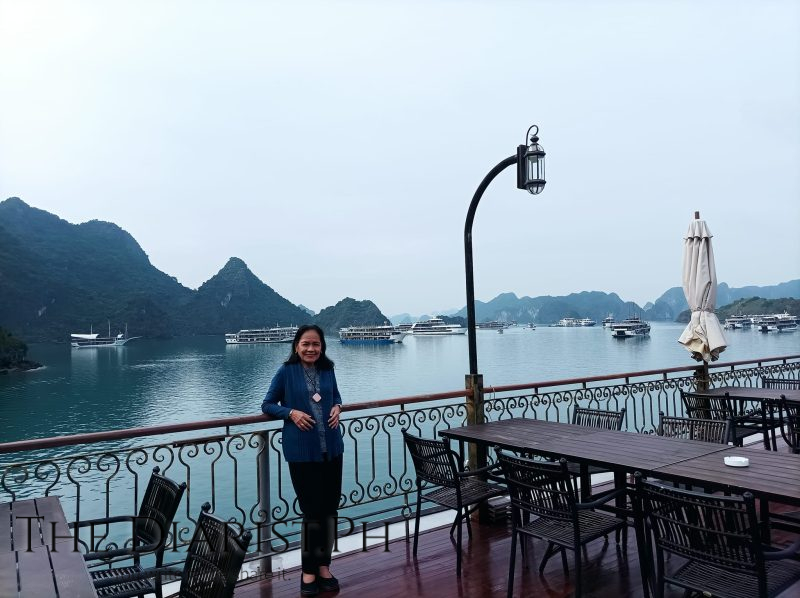
The author gets a view of Halong Bay limestone islands from the ship’s top deck.

Mangrove and limestone islands along Halong Bay
Cruising Halong Bay, a Unesco World Heritage site, made me think of our very own Puerto Princesa Underground River in Palawan, also a Unesco World Heritage site since 1999 and voted a New7Wonders of Nature in 2012. The somewhat murky waters of Halong, according to my marine biologist brother-in-law Mon, could be due to dead corals. Happily, Coron and El Nido have retained the emerald waters and thriving colorful corals and fishes.
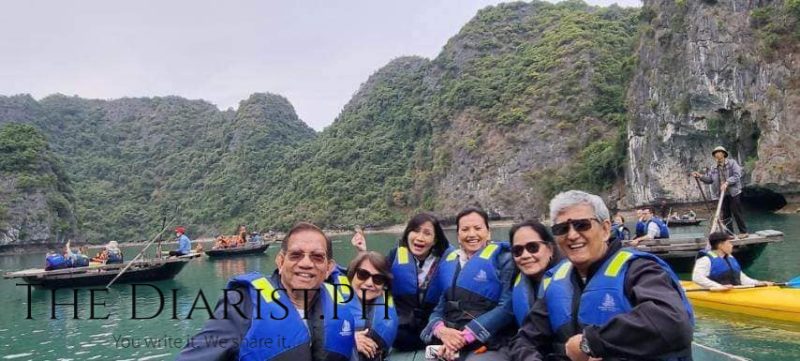
Exploring Bat Cave via sampan

Exploring Bat Cave grotto via kayak
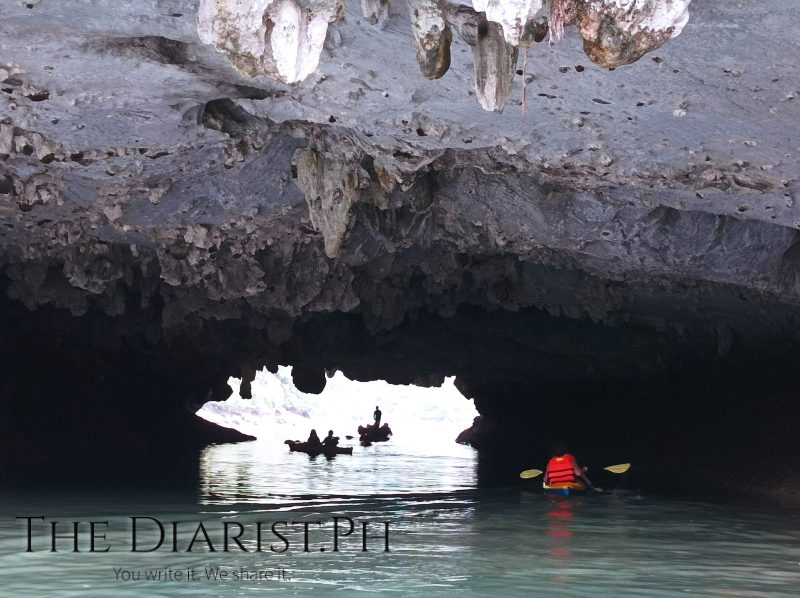
Bat Cave
The cruise was just around Halong Bay overnight. We set off in the morning, had a delightful buffet seafood lunch, and then were asked to choose between sampan or kayak in exploring the limestone structures of Bat Cave, known as Dark and Bright. It was sampan for our group of six, navigated by a jolly native who even offered to take our pictures.
Returning to the ship, we had a nice sit-down dinner after being regaled by a chef’s demo of vegetable and fruit carving. There was a bit of disappointment, though, as their Angus striploin steak came out tough. But service was a delight as we celebrated my sister-in-law Lynn’s 69th birthday with a cake and roses courtesy of the ship. Her husband Dr. Jun Pelina, meanwhile, got her red wine and champagne.

90 Steps up the Trung Trang Cave of Cat Ba Island

Inside the Trung Trang Cave
The following day at 6:30 a.m., we had a light breakfast of coffee, tea, and pastries and transferred to a speed boat for Lan Ha Bay to go to Cat Ba Island. We then took a bus to Trung Trang Cave, passing through Viet Hai, a village with rustic homes. Road construction was going on when we passed the village, and it was heartwarming to see villagers make their own lovely tiles which they used to line the sidewalk. To get to the 300 m-long Trung Trang Cave, we had to take 90 steps up and 100 steps to get down. We then returned to the boat for brunch before going back to the harbor.
At Viet Hai, a village with rustic homes, it was heartwarming to see villagers make their own lovely tiles which they used to line the sidewalk

Dinner at the Indochine cruise ship
The last leg of our wonderful Vietnam sojourn brought us to the Indochina Sails’ Pier at Tuan Chau Port, where our ever-reliable tour guide Quang was already ready with the van for our trip back to Hanoi. We made some stops by the beach and some housing, hotel, and building projects by the VinGroup (Vietnam’s largest conglomerate composed of VinHomes, VinPearl, VinSmart, VinFast Cars, VinSchool, VinUniversity, etc.) in the reclaimed area in Haiphong between Hanoi and Ha Long. Quang mentioned that the VinGroup founder and chairman Pham Nhat Vuong, the first Vietnamese billionaire, started his business in Vietnam and then in Russia and Ukraine.

On a farmer’s herb farm in Hai Phong
We also dropped by a small farmer’s herb farm of basil, coriander, mint, scallions, lettuce, cabbage, and sweet potato. His ancestral tombstones are visible in the back. It was a refreshing site, reminding us of the yummy pho, Vietnamese noodles with lots of basil and lettuce and patis, lime, and chili sweet sauce.
Back in Hanoi, we had a Vietnamese lauriat before proceeding to the airport for our flight home. It was a very organized, comprehensive, and much thought-of trip to this amazing country which has taken a big step forward to benefit the country and its people. If only our Department of Tourism was doing such trips which don’t only provide leisure and vacations, but also showcase the best of our country’s offerings.
All things considered, we could offer more places to show and enjoy, but our infrastructure leaves much to be desired, and there’s no central planning to develop the tourism business better. It’s all about vision and planning and execution, and I just wish we had more leaders who think of our country more than the money they can line their pockets with! Aaah, to dream and to wish the best for our country and people!
Source link
